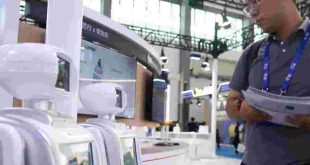Introduction to Drone-as-First-Responder (DFR) Technology
Imagine a scenario where an emergency strikes—a fire breaks out, or someone collapses due to a medical crisis. Time is of the essence, and every second counts. Enter Drone-as-First-Responder (DFR) technology: a game-changer in the world of emergency response. This innovative approach uses drones to deliver immediate assistance and vital information before traditional first responders can arrive on the scene.
While drones have been around for years, their new applications in public safety are transforming how police and medical teams operate during emergencies. From aerial surveillance to real-time data collection, DFR technology promises not only faster responses but also improved outcomes for those in need.
As we explore this fascinating intersection of technology and community service, it’s clear that advancements like Aerovision and intuitive mobile apps are paving the way toward smarter emergency management strategies. Join us as we dive deep into the benefits of DFR technology and its potential impact on our local communities.
Benefits of DFR Technology in Emergency Situations
Drone-as-First-Responder (DFR) technology is revolutionizing emergency response. It offers rapid deployment, which can save crucial minutes when every second counts.
Drones equipped with medical supplies can reach accident scenes faster than traditional ambulances. This quick access to life-saving materials drastically improves survival rates for victims in critical condition.
Additionally, drones provide real-time aerial views of disaster zones. First responders gain valuable situational awareness before they arrive on-site. This information helps them strategize the most effective approach to each unique situation.
The ability to monitor large areas quickly also aids search and rescue operations. Drones enhance communication between teams, ensuring everyone stays informed and coordinated throughout their missions.
Moreover, reducing the need for ground vehicles lowers risks for first responders in hazardous environments. In high-stakes scenarios like fires or floods, this added safety is invaluable as it protects those who are there to help others.
Aerovision: A Revolutionary DFR Platform
Aerovision is at the forefront of transforming emergency response with its innovative DFR platform. This technology harnesses the power of drones to provide first responders with immediate aerial insights.
Equipped with advanced sensors and cameras, Aerovision delivers real-time data during critical situations. Imagine a police unit monitoring crowd dynamics or medical teams assessing accident scenes from above. The benefits are clear: enhanced situational awareness leads to quicker decisions.
The platform integrates seamlessly with existing emergency systems, offering an intuitive interface for operators. Its user-friendly design allows first responders to focus on what matters most—saving lives.
Moreover, Aerovision prioritizes rapid deployment. Within minutes, drones can be airborne, providing crucial information well before ground units arrive at the scene. This capability bridges gaps in communication and reinforces coordination among various agencies involved in emergency management.
Mobile Apps for Real-Time Situation Monitoring
Mobile apps have transformed the landscape of emergency response. They empower first responders with immediate access to critical data during high-pressure situations.
These applications offer real-time updates from drones in the field. First responders can receive live video feeds, mapping information, and situational reports right on their smartphones. This instant connectivity enhances decision-making capabilities significantly.
Moreover, mobile apps facilitate coordinated efforts among police, medical teams, and other agencies. With shared platforms for communication and tracking resources, they ensure everyone is on the same page.
The user-friendly interfaces make it easy for personnel at all levels to utilize these tools effectively. As technology evolves, we can expect even more advanced features that will further refine how emergencies are managed on the ground.
In a world where every second counts, such innovations play a crucial role in saving lives and improving response times.
Community Engagement Dashboard: Empowering Local Communities
The Community Engagement Dashboard is a game-changer for how local populations interact with emergency services. It offers real-time insights into drones deployed in their area, enhancing transparency and trust.
Residents can track the status of drone missions during emergencies. This involvement fosters a sense of security among community members, knowing they have eyes in the sky ready to assist first responders.
Moreover, the platform allows citizens to report incidents directly through user-friendly interfaces. This streamlines communication between locals and emergency personnel, ensuring that critical information flows seamlessly.
By integrating feedback mechanisms within the dashboard, communities can voice concerns or suggest improvements. Empowered citizens are more likely to engage proactively when awareness is heightened.
This level of interaction transforms how we think about response efforts. With technology bridging gaps between first responders and communities, collaboration becomes an integral part of emergency management strategies.
Case Studies: Successful Implementations of DFR Technology
In Miami, DFR technology made headlines when drones assisted police during a critical hostage situation. Equipped with thermal imaging and real-time video feeds, these drones provided crucial intel that helped officers devise an effective response plan.
In another instance, a small town in Colorado utilized drones for medical emergencies. When time was of the essence for a cardiac arrest call, a drone delivered an Automated External Defibrillator (AED) to the scene within minutes. This quick response significantly increased survival chances.
California’s wildfires showcased DFR’s potential for firefighting efforts. Drones equipped with infrared sensors mapped fire spread patterns and identified hotspots, enabling firefighters to focus their resources effectively.
These case studies illustrate how integrating drone technology into emergency services enhances safety and efficiency across various scenarios. Communities are beginning to see the transformative impact of having aerial support during critical incidents.
Future Possibilities and Impact on Emergency Response
The future of Drone-as-First-Responder (DFR) technology holds immense potential. As advancements in drone capabilities continue, we can expect faster deployment and improved operational efficiency.
Imagine drones equipped with advanced medical supplies, arriving at emergency scenes before ground vehicles. They could deliver essential first aid items or even automated external defibrillators to save lives.
Integration with artificial intelligence will enhance decision-making processes for first responders. Drones could analyze real-time data to determine the best course of action during critical incidents.
Furthermore, community partnerships may flourish through shared data platforms. Citizens can contribute local knowledge that helps optimize drone routes, ensuring timely assistance when it matters most.
As regulations evolve, more agencies will adopt this innovative approach. The landscape of emergency response is on the brink of transformation, driven by these cutting-edge technologies and collaborative efforts across communities and agencies alike.
Conclusion
The landscape of emergency response is evolving rapidly, thanks to advancements in Drone-as-First-Responder (DFR) technology. With tools like Aerovision and mobile applications, first responders are now better equipped to handle crises efficiently. These innovations not only enhance real-time situation monitoring but also foster community engagement through interactive dashboards.
As we see successful implementations across various sectors—medical services, police operations, and other emergency scenarios—the potential for drones in life-saving situations becomes increasingly clear. The future holds exciting possibilities as these technologies continue to develop. Their impact on emergency response will likely reshape how communities prepare for and manage emergencies moving forward.
Embracing DFR technology could be the key to a safer future where every second counts in saving lives during critical moments.
 Clicksud
Clicksud


